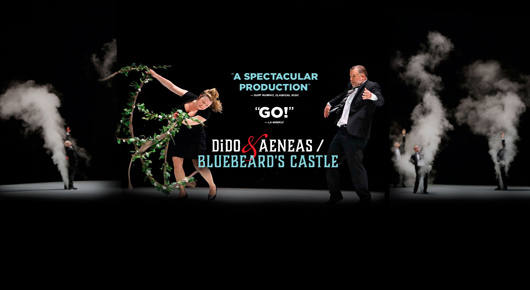
LA Opera’s edgy double feature takes this august art form in other directions and shows the possibilities of different modes of expression for the operatic medium. Both one-act works are directed by Australian Barrie Kosky of the Komische Oper, a world-renowned company located in what was East Germany’s East Berlin. Neither of the current works onstage at the Dorothy Chandler Pavilion is being produced in the mode of tried and true traditional operas – you’ll see no warbling Brünnhilde in metallic breastplates.
Indeed, there is even a bare-breasted performer in Dido and Aeneas, which is first up on stage. Dido and Aeneas is a tragic romance (although performed here with lots of humor) derived from Virgil’s ancient Latin epic poem The Aeneid, written shortly before the birth of Jesus. According to Greco-Roman mythology, Dido (Irish mezzo-soprano Paula Murrihy) was the queen of Carthage (in present-day Tunisia), while Aeneas (Pennsylvania baritone Liam Bonner) was a Trojan prince who, after his romantic sojourn with Dido, proceeded on to help found Rome. British baroque master Henry Purcell composed Dido and Aeneas with a libretto in English by Nahum Tate, first presented circa 1689, when Tate was England’s Poet Laureate.
The staging of this Greco-Roman legend appears to be so primitive that it is now avant-garde. The sets wrought by German scenery designer Katrina Lea Tag, making her LA Opera début, are minimalist; indeed, Dido‘s consists largely of a long white bench in front of a wall. Tag’s costuming are more reminiscent of 17th-century England than the ancient Mediterranean, except for a male/female couple who are clad only in g-strings, feathery haberdashery and, like classical mimes, painted white.
With much comic panache, a trio of cross-dressing Black witches steal the show. The crowd-pleasing Sorceress John Holiday, First Witch G. Thomas Allen, and Second Witch Darryl Taylor are being ballyhooed as opera’s first-time ever threesome of African American countertenors. With their slapstick and vaudevillian flair, this beguiling ménage à trois of transvestites cast a merry spell upon the audience. Even more hilarious is the thought of how old Messrs. Purcell and Tate would have reacted to this scene-stealing silliness injected into what was intended as a tragedy, first performed at a school for éelite young ladies. But they, of course, took liberties with Virgil’s Aeneid: All is fair in love, war and opera.
Purcell’s chamber orchestra has versatile Elliot Graham Figg tickling the ivories on both an organ and a mellifluous harpsichord. A pair of theorbos – long-necked string instruments from 16th-century Italy that can be glimpsed in the orchestra pit and look like lutes or mandolins on steroids – are plucked with aplomb by Richard Savino and Hideki Yamaya, enhancing the bass. The musicians of the ca. 21-piece LA Opera Orchestra mostly played woodwinds and strings, conducted by Steven Sloane. Grant Gershon directed the LA Opera Chorus. At various points the large cast seems to spill offstage and into the aisles.
As Dido and Aeneas is drawn from Greek and Roman sources, with appropriate intervention by the god Jupiter, there is much musing upon “empire growing.” Naturally the founding of Rome, and nothing less than the future fate of Western civilization, imperialism and duty, take precedence over sublime love.
After intermission, 20th-century Hungarian composer Béla Bartók’s sole stab at opera, Bluebeard’s Castle, is decidedly downbeat and minus any comic relief. The libretto is by Hungarian Jewish leftist Béla Balázs, who also wrote the classic Theory of the Film, Character and Growth of a New Art in the 1940s. It’s interesting that a serial wife-killer (here portrayed by British bass-baritone Robert Hayward in his LA Opera debut) also attracted Charlie Chaplin, who used a similar character to lampoon society’s real mass murderers – militaristic leaders of genocidal régimes and wars – in his 1947 post-WWII classic film Monsieur Verdoux.
Although there are imaginative special effects in Bluebeard’s Castle, which premiered on May 24, 1918, in Budapest during the last months of WWI, it does not come across as a black comedy in this production, which is presented on a tilted circular rotating platform with spare sets by the same creative crew as Dido‘s. Bluebeard’s latest bride, Judith (German mezzo-soprano Claudia Mahnke also making her LA Opera debut), explores her new digs at the castle, where she encounters seven locked doors. Having heard ominous rumors about her husband, the zaftig Judith demands seven keys in order to open each locked portal and allow the sunshine in. As to what happens next, let’s just say, beware of what you wish for, because you just might get it. Newlyweds living happily ever after need not apply in this house of horrors with Bartók’s nightmarish, sinister music and recurring blood motif.
Whereas Purcell relied upon ancient myths for his inspiration, Bartók partakes of European folklore, with a much smaller cast. Both are sagas about love gone terribly wrong, presented with innovative stagecraft and an experimental sensibility. Viewers might mistakenly believe they are across the street and down the block at REDCAT. But no; with both of these hour-long pieces, LA Opera is taking chances and artistically opening things up, proving once again, as it did a few years ago with its cutting edge Ring, that this opera house can present customary, conventional fare, as well as risk-taking, formally challenging works along with the best of ’em. Leave your metal breastplates at home.
Dido & Aeneas and Bluebeard’s Castle are being performed Nov. 6, 12, and 15 at 7:30 pm, and on Nov. 2 and 9 at 2:00 pm at LA Opera at the Dorothy Chandler Pavilion, 135 N. Grand Ave. For more info: (213) 972-8001; www.laopera.com.
Photo: laopera.org










